Seven Keys to More Effective Recruiter Onboarding
Modernize Your Onboarding Program to Grow Your Business and Retain Your Employees

-
Table of Contents
- Introduction
- #1: Training Content Should Be Quick, Easy to Create, Absorb, and Access
- #2: Knowledge Training Should Be Segmented From Skills Training
- #3: Experiential Skills Training Should Be the Star of the Show
- #4: Modern Recruiter Onboarding Content Should Be Highly Structured and Sequenced
- #5: Onboarding Should Certify Recruiter Knowledge and Skills Competency With Assessments
- #6: Onboarding Should Include Automated, Intuitive Reinforcement Mechanisms
- #7: Learning Should Be Continuous, Ongoing, and Bite-Sized
- Next Steps
.png?width=400&name=macbook-pro-over-glass-desk-in-business-room-wide%20(1).png) The past few years have seen learning technology and practices advance by leaps and bounds. Yet, most staffing and recruiting firms continue to rely on outdated recruiter onboarding methods that rarely produce business results or move the revenue needle.
The past few years have seen learning technology and practices advance by leaps and bounds. Yet, most staffing and recruiting firms continue to rely on outdated recruiter onboarding methods that rarely produce business results or move the revenue needle.
The typical staffing or recruiting firm today:
- Neglects to take full advantage of modern learning practices and technology
- Struggles to make recruiter onboarding more efficient (reducing ramp-up time) and more effective (improving results during ramp-up and after onboarding)
- Takes top performers off-line to facilitate shadow training
- If your recruiter onboarding process is stuck in the past, it’s time to evolve. By adopting modern learning practices and innovative technology, you can transform your staffing firm’s new recruiter onboarding program into an organizational capability that drives revenue growth and fosters employee retention.
Well-designed recruiter onboarding programs:
- Speed time-to-productivity for new recruiters
- Improve production levels during the ramp-up period (compared to previous group cohorts)
- Reduce the time commitment required of recruiting leaders
- Lower travel and entertainment expenses by empowering teams to learn remotely
From our work with hundreds of staffing and recruiting firms — training and coaching thousands of recruiters — we have gained insight into the best practices that consistently deliver optimal recruiter onboarding results.
We’ve distilled everything we’ve learned from organizations that have adopted modern recruiter onboarding into seven fundamental principles:
- Training Content Should Be Quick, Easy to Create, Absorb, and Access
- Knowledge Training and Skills Training Should Be Segmented
- Experiential Skills Training Should Be the Star of the Show
- Onboarding Content Should Be Highly Structured and Sequenced
- Onboarding Should Certify Recruiter Knowledge and Skills Competency with Assessments
- Onboarding Should Include Automated, Intuitive Reinforcement Mechanisms
- Learning Should Be Continuous, Ongoing, and Bite-Sized
We’ll explain each of these principles in the following pages and discuss how to apply them to your firm’s onboarding program. As you will see, strong instructional design coupled with a performance management approach to recruiter onboarding and infused with modern learning practices produces compelling and measurable business results.
Keep in mind, however: Nowhere do these principles dictate abandoning traditional training methods. Like any practical innovation, modern onboarding builds on the past. Modern recruiter onboarding takes what we’ve learned about training and combines new practices and technology to make the leap forward.
#1: Training Content Should Be Quick, Easy to Create, Absorb, and Access
%20(1).png?width=400&name=Mobile%20phone%20image%20(1)%20(1).png) Much of this guide addresses the type of content you should include in your training program for new recruiters. But first, we’ll address how to deliver that content.
Much of this guide addresses the type of content you should include in your training program for new recruiters. But first, we’ll address how to deliver that content.
Five modern technologies make training content quick and easy to create, absorb, and access.
Mobile Devices
Your recruiters — like everyone else — carry their smartphones with them throughout every waking hour. By making your content mobile-friendly, you can make it easy for your organization to meet your recruiters where they live and work.
Video
The human brain processes visual information 60,000 times faster than it does text. Video is the quickest and easiest way to replicate winning behaviors across your recruiting organization.
Artificial Intelligence (AI)
The days of each employee needing to learn the exact same material as every other employee are a thing of the past. AI can personalize content to suit the needs of each learner, focusing on their individual skill and knowledge gaps. AI recommends suitable content to the individual learner based on past behavior and performance.
Peer-to-Peer Learning (Social Learning)
In the peer-to-peer learning model (also known as social learning) new recruiters, managers, support staff, and leaders’ ability to quickly and easily create and share video content from their mobile device opens new ways for collaboration throughout a distributed recruiting organization.
Subject matter experts, senior leaders, recruiting managers, and top-performing recruiters across vertical domains and geographical locations use these technologies to contribute to the learning experience.
Microlearning
Microlearning (which includes animated microlearning videos) is a learner-centric approach that delivers just-in-time training via devices such as computers, tablets, and smartphones.
Microlearning appeals to learners by allowing them to define their learning paths.
Microlearning is personalized and flexible, two ingredients all learners, especially millennials, covet. These aspects ensure that training can be easily accessed, quickly completed, and applied by the learners.
Finally, microlearning is agile and can be used to create “sticky” learning experiences that help overcome the “forgetting curve.”
#2: Knowledge Training Should Be Segmented From Skills Training
New recruiters need to learn a lot of things quickly. Whether it’s understanding how to read and qualify a job description, overcome common candidate objections, or pitch a candidate to a hiring manager, your content repertoire needs to communicate everything a recruiter would need for success in an organized manner.
Modern staffing and recruiting firms optimize time-to-productivity for new hires by segmenting knowledge training from skills training.
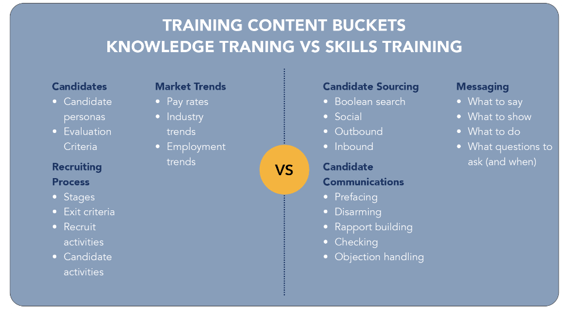
Knowledge Training
Knowledge consists of concepts and principles committed to memory. You can go to a trusted resource, make a query, and gain new knowledge. Once memorized, you’re able to access that knowledge at any time without consulting the original source.
Common examples of recruiter knowledge include:
- Understanding candidate personas
- Pay rates
- Industry and market details
- Your recruiting process, including the stages and activities associated with each stage, as well as your exit criteria
Skills Training
Skills training teaches learners “how to do things.” Through skills training, people can improve their capabilities, capacity, productivity, and performance. Skills are developed and mastered through experiential learning.
(We will cover experiential learning in more detail in the next chapter.)
Common examples of recruiter skills (among many others) include:
- Disarming
- Objection handling
- Empathy
- Critical thinking
- Positioning
- Questioning
- What sets modern recruiting organizations apart from the rest is they know that both knowledge training and skills training are required to advance a recruiter’s career and increase their value to the business — including to the candidates and customers they serve. You can’t have one without the other.
For example, knowledge of the recruiting process, job function, and pay rate is useless if the recruiter lacks the soft skills to open a dialogue with a candidate, uncover their needs, and identify and address their concerns.
#3: Experiential Skills Training Should Be the Star of the Show
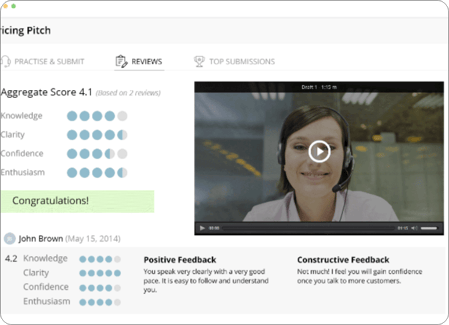 In our work with over 400 staffing and recruiting firms, we’ve learned that the majority of recruiting firms focus exclusively on teaching their recruiters their recruiting process and not the underlying skills. Most recruiting firms make their applicant tracking system (ATS) the focal point of recruiter onboarding, in which they show their new hires:
In our work with over 400 staffing and recruiting firms, we’ve learned that the majority of recruiting firms focus exclusively on teaching their recruiters their recruiting process and not the underlying skills. Most recruiting firms make their applicant tracking system (ATS) the focal point of recruiter onboarding, in which they show their new hires:
- How to enter a candidate
- How to upload a candidate resume
- How to attach a candidate profile/resume to a job order
- How to document notes on a candidate record
This is recruiter process training. It explains the “what” of a recruiter’s job responsibilities.
While it is important for your recruiters to understand your recruiting process, recruiter process training on its own fails to accelerate time-to-first-placement or quota attainment or give your recruiters any competitive differentiation. Automation technology might replace repetitive tasks and processes, but nothing can replace human emotional intelligence and complex critical thinking.
Modern recruiting firms incorporate experiential learning into their onboarding. Experiential learning is the practice of learning through doing. This learning technique encourages students to have first-hand experiences with materials and people — also known as use cases — rather than learning through someone else’s lectures or textbooks.
“Experiential learning is the practice of learning through doing. This learning technique encourages students to have first-hand experiences with materials and people — also known as use cases — rather than learning through someone else’s lectures or textbooks.”
According to the latest research, learners retain 75% of what they learn by doing, compared to just 5% of what they hear or 10% of what they read. In a distracting world, experiential learning keeps learners engaged and attentive to the goal at hand.
What sets modern staffing and recruiting firms apart from the pack is that experiential learning constitutes over 70% of their recruiter onboarding and enablement.
#4: Modern Recruiter Onboarding Content Should Be Highly Structured and Sequenced
Another key theme to emerge from designing hundreds of recruiter onboarding programs is that there is a right way and wrong way to structure and sequence onboarding content. To avoid new hire turnover and see results rapidly, your recruiter onboarding content must be highly structured and properly sequenced.
The most impactful recruiter onboarding programs we’ve seen organize their content by:
- Stage of the recruitment process
- Recruiter activities associated with each stage
- Requisite skills (skills training) required to execute each stage
- Requisite knowledge (knowledge training) required to execute each stage
For example, assume the steps below depict the first three stages of the recruitment process.
- Source
- Engage and phone screen
- Interview
The most effective and efficient recruiting firms enroll their new hire recruiters in the knowledge training they need for each stage, followed by the skills training they need to execute each stage. Because these recruiting firms use microlearning and video, they can choose which new hires get invited to which training modules and when during their onboarding journey.
Finally, and perhaps most importantly, the training is delivered in bite-sized pieces.
#5: Onboarding Should Certify Recruiter Knowledge and Skills Competency With Assessments
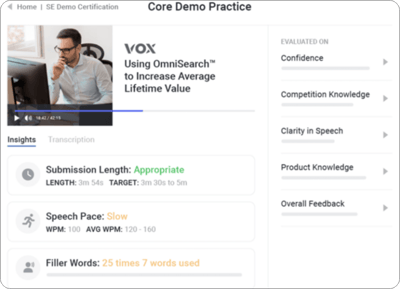
Recruiters need to be able to engage in meaningful candidate conversations to win. To do so, they need to feel confident and prepared, and managers need the confidence in knowing that every recruiter is “conversation ready.”
To that end, modern recruiting leaders use competency assessments to certify that their recruiters have retained the knowledge and skills learned during onboarding to deliver the message consistently.
Assessments objectively appraise a learner’s competencies — including comprehension and retention of skills and knowledge — by administering true/false, multiple-choice, essay, and fill-in-the-blank questions.
Competency assessments may also include experiential learning exercises, in which new hires video record themselves practicing their pitch, running a candidate negotiation, or handling a candidate objection.
Aided by automated AI assessment reviews, recruiting managers review the videos and score each recruiter on their ability to apply the knowledge and skills taught during onboarding.
How Frequently Should Recruiters Be Assessed?
To keep the pressure on and to ensure all recruiters can consistently stay on message, recruiting leaders require their recruiters to participate in competency competitions with their peers for months, and in some cases years, post onboarding.
Competency assessments are the backbone of modern recruiter onboarding, ensuring skill and knowledge retention and adoption.
#6: Onboarding Should Include Automated, Intuitive Reinforcement Mechanisms
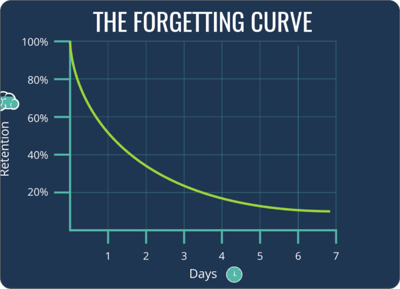
Research shows that people forget 80% of what they learn within a month of training. The “forgetting curve” is real.
How can you help your new hires retain the information they learned? How do you ensure your recruiters use it so they don’t lose it?
The key is to conduct ongoing reinforcement exercises with spaced repetition.
If competency assessments are the backbone of new hire onboarding, reinforcement is the muscle that holds everything together. Modern recruiter onboarding programs use AI, machine learning, and other advanced technologies to push automated, daily reinforcement exercises to each recruiter’s mobile device using spaced repetition — a method of spacing learning over time for maximum retention.
Adaptive, automated spaced reinforcement gives recruiting leaders a way to reinforce a body of knowledge or skills in bite-sized pieces over time without overloading recruiters. You can provide recruiters with fun, easy, gamified exercises on an ongoing basis to help them absorb and retain what they learned so they can consistently apply their knowledge and skills in candidate conversations.
#7: Learning Should Be Continuous, Ongoing, and Bite-Sized
Many staffing and recruiting firms neglect continuous training due to the perceived short-term dip in employee productivity. However, a quick ROI analysis reveals that the long-term benefits of training far outweigh any initial setback.
Modern recruiting leaders believe organizations are driven by employees who want to learn. These employees will feel that they’re valued team members if their employers choose to invest in their professional development. Modern recruiting leaders view continuous staff training as a savvy business decision and an ethical obligation.
Industry, technology, and competition evolve with the times, and therefore, onboarding should extend well beyond initial orientation. What makes modern recruiter onboarding “modern” is that it ensures staff members possess up-to-date skills and knowledge to keep pace with change and avoid becoming irrelevant.
Recruiting leaders foster a strong learning culture by providing content that meets the needs and preferences of their employees. This includes up-to-date content delivered in a variety of formats, including:
- Video
- Interactive e-learning
- Experiential learning
- E-books
All these resources are made available to employees whenever and wherever they need them via their mobile devices.
By spreading learning over time and breaking it up into bite-sized pieces, you can reduce the cognitive load on your recruiters and ease the perceived burden of learning. Studies show that this gives people a sense of empowerment and thus produces better training outcomes.
People learn more naturally when training is spaced out over time. This approach promotes the more autonomous, self-directed capacity that underpins a learning culture. The short, single-subject nature of microlearning, in particular, fits easily into employees’ busy schedules, helping them cultivate a daily habit of developing new skills.
Please complete the form to the right to download this ebook.
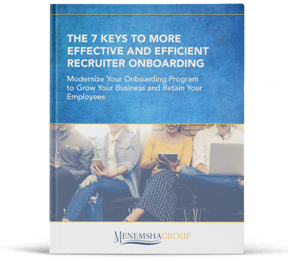
Next Steps
To learn more about Menemsha Group’s sales and recruiter enablement solution including how we leverage innovative technology and modern learning methods to make winning behaviors repeatable and deliver predictable revenue growth, download our eBook, Menemsha Group’s Sales & Recruiter Enablement Roadmap for Scalable Growth. In the eBook you will discover the tools, technologies, techniques, methodologies, content and processes we employ to help staffing and recruiting firms attain scalable, repeatable success.



